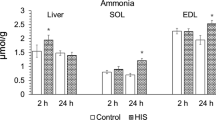Summary
The influence of modified electroconvulsion therapy (E.C.T.) on a patient in established renal failure was studied. Cardiovascular responses were minimal and short lived. A significant change in plasma potassium levels occurred 2 and 5 minutes after succinylcholine and E.C.T. (<0.05 and P<0.02), the increase being within normal limits. It is suggested that electroshock therapy should not be withheld from patients having regular dialysis if this form of treatment is required.
Similar content being viewed by others
References
Aurigemma, N. M., Feldman, N. T. 1977. Arterial oxygenation during haemodialysis. N. Eng. J. Med. 297, 871–873.
Bali, I. M. 1974. The effect of modified electroconvulsive therapy on plasma potassium concentration. Br. J. Anaesth. 47, 398–401.
Blazer, M. D., Petrie, W., Wilson, W. P. 1976. Affective psychosis following renal transplant. Dis. Nerv. Sys. 37, 663–667.
Bischel, M. D., Scoles, B. G., Mohler, T. G. 1975. Evidence of pulmonary microembolization during haemodialysis. Chest 67, 335–337.
Cox, M., Sterns, R. H., Singer, I. 1978. The defence against hyperkalaemia: the role of insulin and aldosterone. N. Eng. J. Med. 299, 525–528.
Day, S. 1976. Plasma potassium changes following suxamethonium in normal patients and in patients in renal failure. Br. J. Anaesth. 48, 1011–1015.
Goggin, M. J., Joekes, A. M. 1971. Gas exchange in renal failure—Part I: dangers of hyperkalaemia during anaesthesia. Brit. Med. J. ii, 244–247.
Harte, M., Ennis, J., Horgan, J. H. 1981. The effect of direct current countershock on the myocardium. Irish J. Med. Sci. 150, 38–40.
Haw, M. E. 1972. Variation in serum potassium during electroconvulsion therapy in patients anaesthetized with thiopentone and methohexitone. Br. J. Anaesth. 44, 707–711.
Jebsen, R. H., Teckhoff, H., Honet, J. C. 1976. Natural history of uraemic polyneuropathy and effects of dialysis. N. Eng. Med. J. 277, 327–330.
Kalow, W., Genest, K., Staron, N. 1956. Kinetic studies on the hydrolysis of benjoycholine by human serum cholinesterase. Can. J. Biochem & Phys. 34, 637–642.
Ryan, D. W. 1977. Pre-operative serum cholinesterase concentration in chronic renal failure. Br. J. Anaesth. 49, 945–949.
Strunin, L. 1966. Some aspects of anaesthesia for renal homo-transplantation. Br. J. Anaesth. 38, 812–822.
Valentin, N., Skovste, P., Danielsen, B. 1973. Plasma potassium following suxamethonium and electroconvulsion therapy. Acta. Anaesth. Scand. 17, 197–202.
Author information
Authors and Affiliations
Rights and permissions
About this article
Cite this article
MacEvilly, M., Riordan, D., Ryan, J.P. et al. Electroconvulsion therapy and the haemodialysis dependent patient. I.J.M.S. 152, 392–393 (1983). https://doi.org/10.1007/BF02960752
Issue Date:
DOI: https://doi.org/10.1007/BF02960752




